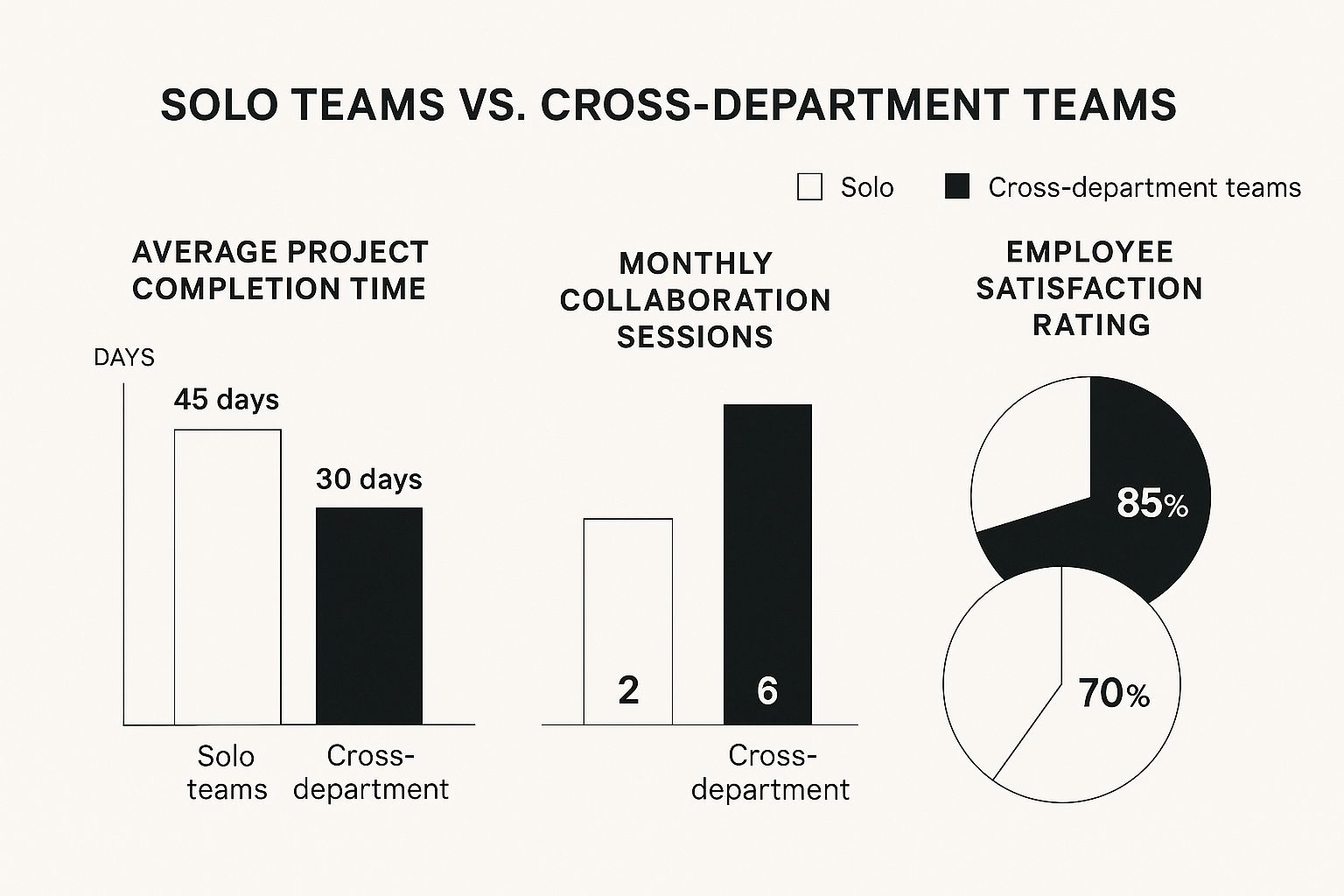Master Cross Department Collaboration for Business Growth
- Matthew Amann

- Jul 1
- 14 min read
What Cross-Department Collaboration Actually Looks Like
Forget the textbook definition for a moment. True cross-department collaboration is less about formal processes and more about creating a kind of organizational magic. Think of it like a skilled film crew, where the sound, lighting, and camera departments—each a master of their own craft—work in perfect sync to create a blockbuster hit.
It’s not just about different teams sharing a Google Doc. It’s about weaving together unique perspectives and skills. Imagine marketing's deep understanding of the customer, engineering's technical prowess, and sales' real-world feedback all converging on a single project. This is where you move beyond simple cooperation and start creating something truly innovative that no single team could have built on its own.
It's a Modern Business Imperative
In today's world, this kind of teamwork isn't just a "nice-to-have" anymore; it's a core business strategy. The old model of rigid, walled-off departments just can't keep up. To stay agile and responsive, companies are intentionally breaking down those traditional silos.
The goal is to evolve from a collection of isolated groups into one cohesive unit, with everyone laser-focused on the same objective. This shift is what sparks creativity, speeds up decisions, and makes sure the entire company is pulling in the same direction.
The data backs this up. In 2024, a remarkable 83% of companies reported relying on cross-functional teams that bring together people from marketing, engineering, sales, and more. These blended teams are proving essential for keeping everyone aligned with the company's bigger goals. You can dig deeper into the latest cross-functional team collaboration statistics to see the full picture.
The Real-World Impact
So, what does this actually look like on the ground? It’s when:
Marketing and Sales team up to build a campaign using shared lead data. The result? The message is perfectly consistent, from the first ad a customer sees to the final sales pitch.
Product Development and Customer Support start holding joint weekly meetings. Suddenly, engineers are hearing about user frustrations directly, allowing them to fix bugs faster and build features people genuinely need.
Finance and Operations work together on budget forecasting for a new initiative. This simple act of collaboration prevents those last-minute resource scrambles and helps ensure the project is profitable from day one.
This is the kind of integrated teamwork that sets market leaders apart. It's not just a buzzword; it’s a critical capability for any business that wants to grow and adapt in a constantly changing world.
Why Breaking Down Silos Is a Business Imperative
Organizational silos are more than just an internal headache; they're genuine roadblocks to growth. When teams work in their own little bubbles, they create echo chambers that kill creativity and make it agonizingly slow to react to market shifts. Tearing down these walls isn't about forced fun or friendship—it's a core business strategy for building a more agile and competitive company.
Think of your company's collective knowledge as a massive library. In a siloed business, each department is locked in a separate room with just a handful of books. True cross-department collaboration throws open all the doors, giving everyone access to the entire collection. This instant access to different perspectives and skills is what speeds up problem-solving and helps you spot opportunities you'd otherwise miss.
The Innovation Engine
Real innovation almost never happens in isolation. It’s born from the friction and fusion of different ideas and disciplines. When marketing’s deep understanding of the customer collides with engineering’s technical prowess, that's where truly remarkable products come from. This collaborative friction is a powerful engine for progress, turning separate efforts into unified breakthroughs.
For a deeper dive into practical strategies for breaking down silos in the workplace, it's worth exploring resources that offer clear, actionable advice.
A classic example of this in action is Apple’s "Project Purple," the internal codename for the development of the first iPhone. The project famously pulled together separate hardware, software, and design teams, forcing them to operate as one cohesive unit. That unified effort was absolutely critical to the iPhone's revolutionary launch and its continued dominance.
Despite the clear benefits, research shows 75% of cross-functional teams are dysfunctional, meaning they fail to meet their own goals. Overcoming this common struggle is what separates true market leaders from everyone else.
Blending teams is tough, no doubt about it. But when it works, the payoff is huge. The success of "Project Purple" proves that when you successfully merge diverse expertise, the result can redefine an entire industry.
From Disconnected Teams to a Unified Mission
Beyond just making better products, breaking down silos has a massive impact on your most important asset: your people. A truly collaborative culture gives everyone a sense of shared purpose and ownership over the company's success. When employees can clearly see how their individual work plugs into the bigger picture, their engagement and morale go through the roof.
The image below really drives this point home, showing how this isn't just theory but a fundamental part of modern business strategy.

This visual reinforces the idea that integrating diverse teams, as Apple did with the iPhone, is essential for achieving truly ambitious goals.
This boost in morale isn't just a "feel-good" metric; it delivers real, tangible results.
Higher Retention: People who feel connected to their colleagues and the company's mission don't just punch a clock. They're invested, and they stick around.
Increased Productivity: A shared mission motivates teams to help each other out, removing friction and clearing roadblocks much faster than they could alone.
Stronger Culture: Collaboration naturally builds trust and mutual respect—the bedrock of a positive, resilient, and supportive company culture.
At the end of the day, making cross-department collaboration a priority is non-negotiable. It sharpens your innovative edge, makes you more responsive to the market, and builds an engaged, unified workforce ready to take on whatever comes next.
Navigating the Common Roadblocks to Teamwork

We all know teamwork is supposed to make the dream work, but getting different departments to collaborate effectively is rarely a walk in the park. The path is often full of stubborn obstacles that can stop even the best-intentioned efforts in their tracks. Recognizing these challenges is the first real step toward breaking them down.
One of the biggest hurdles? Conflicting departmental goals. It’s a classic story. The marketing team is running a six-month brand awareness campaign, playing the long game. At the same time, the sales team is laser-focused on hitting aggressive quarterly numbers. Right there, you have a fundamental disconnect. Their incentives don't just fail to align; they actively work against each other, creating friction where you need teamwork.
This kind of misalignment is what feeds an "us vs. them" culture. Before you know it, departments stop seeing each other as partners and start viewing them as roadblocks. Information gets hoarded, and the blame game starts the second a project hits a snag.
Gaps in Communication and Leadership
Another major issue is that teams often speak completely different languages. Seriously. The engineering team might be talking about "API latency" while the legal team is worried about "indemnification clauses." To everyone else, it’s just jargon. Without a common language or a real effort to simplify, misunderstandings are guaranteed to happen, and work grinds to a halt.
These problems get even worse when there's a lack of leadership. If no one is assigned to own a cross-functional project—to set a clear direction, mediate disagreements, and keep everyone on track—teams are left to fend for themselves. This is a primary reason so many great ideas fizzle out. Pushing past these hurdles is absolutely essential to streamline operations and boost efficiency today.
The Challenge of Shared Success
Finally, let's talk about credit. True collaboration means everyone shares in the victory, but that can be a tough pill to swallow for star players who are used to getting all the glory. This isn't some new-age corporate problem; it's a deep-seated human dynamic.
A 30-year study from MIT dug into this very issue. It found that while scientists who collaborated produced higher-quality work, their individual output often dipped, and figuring out who deserved credit became a huge headache.
This research really gets to the heart of the matter: a big win for the group can feel like a personal loss if recognition isn't handled with care. If you want to build a culture where collaboration can actually flourish, you have to get out ahead of these roadblocks and deal with them head-on.
7 Practical Steps to Build a Truly Collaborative Culture

Great cross-department collaboration isn't something that just happens. It’s built brick by brick, with intention and consistent effort. If you want teamwork to be the default setting—not a rare exception—you need a practical playbook. This means moving beyond vague goals and putting concrete, repeatable practices into place.
It all starts with giving everyone a single, unifying vision they can get behind, no matter which department they're in. This isn't just a mission statement tacked on a wall. It's a clear, compelling picture of a shared destination that's bigger than any one team's individual metrics. When the sales team and the product team are both rowing toward the same north star, their daily priorities naturally begin to sync up.
1. Establish Clear Rules of Engagement
To bring that vision to life, your teams need a common language for how they’ll work together. Setting up clear "rules of engagement" is the best way to prevent the friction that comes from mismatched expectations. This framework should spell out how decisions get made, how disagreements are handled, and who has the final say on projects that cross team lines.
These rules are what create psychological safety—an environment where people feel comfortable enough to float new ideas, ask tough questions, and even admit mistakes without getting thrown under the bus. When people from different departments genuinely trust each other, they’re more willing to be vulnerable, which is where real innovation and problem-solving happen.
A culture of psychological safety means that team members are no longer just responsible for their specific tasks. Instead, each person shares responsibility for the outcome of the entire project, fostering a powerful sense of collective ownership.
This sense of shared responsibility is what finally kills the "that's not my job" mentality and encourages people to proactively help each other out.
2. Standardize Your Tools
With a shared vision and clear rules in place, you need to give your teams the right gear. Standardizing your communication and project management tools is a non-negotiable. If one team is on Trello, another is deep in Asana, and a third is running their world on spreadsheets, information will inevitably get siloed and workflows will grind to a halt.
Having a standardized set of tools creates a single source of truth, making sure everyone is looking at the same information. This consistency is the bedrock of smooth handoffs and transparent progress tracking. You can find out more about connecting different systems by checking out these top business process automation examples to boost efficiency.
3. Celebrate the Wins (Together)
Finally, you have to reinforce the behavior you want to see. When a project hits its goals because of amazing teamwork, make a big deal out of it. Shine a spotlight on the entire cross-functional team, not just the individual heroes.
Here are a few simple ways to make collaborative wins a part of your company culture:
Public Recognition: Give shout-outs in company-wide meetings or newsletters that specifically call out successful cross-department collaboration.
Team-Based Incentives: Structure bonuses or other rewards around the success of collaborative projects, not just individual performance.
Success Story Breakdowns: Host sessions where teams can walk everyone through how they worked together to crack a tough problem, turning their win into a lesson for the whole organization.
By putting these strategies into action, you're not just crossing your fingers and hoping for collaboration. You’re actively engineering the cultural foundation it needs to flourish.
Building Your Collaborative Technology Stack
Let's be honest, the right tools can make or break your cross-department collaboration efforts. You can have the best strategy and a great culture, but without the right tech, your teams are working with one hand tied behind their backs. The technology you use is the digital nervous system that connects everyone.
Building a great tech stack isn't about just buying more software. It's about choosing the right software and, more importantly, making sure it all plays nicely together. Think of it like building with LEGOs versus just having a random pile of bricks. Each tool needs a clear purpose, working to bridge divides instead of accidentally creating new digital islands. A well-designed stack makes teamwork the path of least resistance.
To get started, it helps to understand the two main flavors of collaboration tools and when to use each one.
Synchronous vs. Asynchronous Tools
Synchronous tools are for "right now" conversations. They’re built for real-time chats and quick-fire problem-solving sessions, perfect for when you need to hash out an urgent issue or get a fast decision. We're talking about tools like Slack or Microsoft Teams—they're the digital version of pulling a few people into a conference room to talk something through.
Asynchronous tools, on the other hand, are for "over time" work. Platforms like Asana, Trello, or Jira are designed for managing projects where people contribute on their own schedules. They create a central, organized place for tasks, updates, and files, ensuring work moves forward even if your team is spread across different time zones or juggling other priorities.
A classic mistake is relying on synchronous tools for everything. When critical project details get buried in a fast-moving chat channel, information vanishes and accountability suffers. The real magic happens when you use each tool for what it was built for.
This isn't just about feeling more connected. When teams have the right tools to collaborate effectively, the business results are undeniable.

As the numbers show, well-supported cross-department teams don't just work better together; they deliver faster and are happier doing it.
Finding the Right Mix of Tools
Choosing the right applications can feel overwhelming, but breaking it down by function helps. Your goal is to create a seamless ecosystem where information can flow without hitting roadblocks.
To help visualize this, here’s a look at different tool categories and where they fit into a collaborative workflow.
Choosing the Right Collaboration Tool
Tool Category | Primary Use Case | Best For | Example Tools |
|---|---|---|---|
Instant Messaging | Real-time, synchronous chat and quick questions. | Urgent issues, fast decisions, and informal team building. | Slack, Microsoft Teams, Google Chat |
Project Management | Asynchronous task tracking and long-term project planning. | Defining workflows, assigning tasks, and monitoring progress. | Asana, Trello, Jira, Monday.com |
Knowledge Hub / Wiki | Centralized documentation and "single source of truth." | Storing SOPs, project briefs, company policies, and meeting notes. | Notion, Confluence, Slite |
Video Conferencing | Face-to-face virtual meetings and presentations. | Team check-ins, client calls, and detailed planning sessions. | Zoom, Google Meet, Webex |
Cloud Storage | Secure file sharing and document collaboration. | Co-editing documents, sharing large files, and version control. | Google Drive, Dropbox, OneDrive |
Ultimately, having a variety of tools isn't the problem—it's when they don't talk to each other that friction builds up.
The Central Hub and Seamless Integration
At the heart of any great tech stack is a centralized knowledge hub. This is your company's single source of truth—a platform like Notion or Confluence where all crucial information lives. This prevents knowledge from getting siloed in different apps, email threads, or people's heads.
Even with the best tools, however, manual handoffs between them are slow and prone to error. This is where automation changes the game. If you're looking for ideas, you can explore some of the best collaboration tools for distributed teams to see what's out there.
By integrating these separate apps, you can create automated workflows that pass information from one system to another without anyone lifting a finger. To learn more about connecting your systems, our guide to business process automation is a great next step. This is how you build a truly connected environment where information flows freely and silos simply can't survive.
Putting Your Teamwork on Autopilot with Automation
Even with the best intentions and the right tools, manual handoffs are where teamwork breaks down. They’re the little gaps in the process where key information gets lost, tasks fall through the cracks, and deadlines slip. The fix isn't to work harder; it's to let automation act as the connective tissue for your cross-department collaboration.
Think of workflow automation platforms like Zapier or Make.com as digital translators. They allow the different software your teams already use to talk to each other, creating simple "if this happens, then do that" sequences that run in the background. This isn't just a time-saver. It's about building a reliable, self-sustaining system for how your teams work together.
How Automated Workflows Bridge Departmental Gaps
Picture this: a sales rep finally closes a big deal in your CRM. In a completely manual world, that person now has to kick off a flurry of activity—emailing the project manager, Slacking the finance team, and hunting down the right folder to upload the contract. Each of those steps is a potential point of failure.
Now, let's see how it looks with automation. That single "deal closed" status change can trigger a perfect domino effect:
A new project instantly appears in the delivery team’s Asana board, pre-populated with all the customer's details from the CRM.
Finance gets an alert in their dedicated Slack channel, with a direct link to the sales record so they can prep the invoice.
A new client folder is automatically created in Google Drive, and the signed contract is filed away exactly where it belongs.
This kind of connected system practically guarantees that your process is followed the same way every time, which naturally increases accountability. A huge part of this involves automating document workflows, a step that can dramatically cut down on the manual busywork between departments.
Automation transforms collaboration from a series of disjointed manual tasks into a single, seamless flow. It ensures that the right information gets to the right people at the right time, every single time.
The very act of setting up these automated workflows forces teams to get crystal clear on their handoff procedures. You have to define exactly what information is needed, by whom, and when. Just mapping this out often shines a light on hidden bottlenecks you never knew you had.
By putting routine collaboration on autopilot, you give your people back their most valuable resource: time. They can stop chasing updates and spend their energy on the creative, strategic work that actually drives the business forward. It's the most effective way to build smoother, more dependable teamwork.
Answering Your Cross-Department Collaboration Questions
Even the best-laid plans run into real-world questions once you start putting them into practice. Thinking through these common sticking points ahead of time can be the difference between a collaboration initiative that thrives and one that fizzles out. Let's tackle a few of the most frequent questions we hear from teams on the ground.
How Do We Actually Measure the ROI?
This is a big one. It's tempting to look for a single dollar figure, but the true return on investment (ROI) for great collaboration often shows up in operational improvements first. The key is to track metrics that directly connect to efficiency and output.
You can start by looking at:
Project Completion Speed: Are projects moving from start to finish faster than they used to? Track the before-and-after timelines.
Fewer Errors: A classic sign of poor handoffs is the amount of rework required. Monitor how often work has to be redone or corrected as it moves between teams. A drop here is a huge win.
Hard Business Outcomes: Tie your efforts back to core business goals. Are customer satisfaction scores climbing? Is your time-to-market for new products getting shorter? These are the results that really matter.
Where Should Marketing and Sales Start?
If you want to get marketing and sales on the same page, the single most effective first step is to build a Service Level Agreement (SLA). Think of it less as a stuffy corporate document and more as a pact or a shared rulebook.
An SLA forces both teams to sit down and hammer out the details. You'll agree on what a "good lead" actually looks like (MQL vs. SQL), set a non-negotiable schedule for pipeline reviews, and build a shared dashboard so everyone is looking at the same numbers.
It's this act of mutual agreement that creates real alignment and accountability.
What Happens When Priorities Clash?
They will. It's not a matter of if but when different departments have conflicting priorities. The trick is to have a system in place before the conflict arises.
For any major cross-functional project, assign a single, empowered project owner. This person is the designated tie-breaker. Their authority cuts through the "he said, she said" and keeps the project from getting deadlocked. It's also crucial that every department's goals are clearly tied to the company's main objectives. When everyone can see how their piece contributes to the bigger picture, it becomes much easier to pull in the same direction.
Ready to eliminate the manual handoffs and communication gaps that slow your teams down? Flow Genius designs and implements smart automation solutions that connect your departments and streamline workflows, giving you back valuable time. Discover how our custom automation services can boost your team's productivity today.
Comments